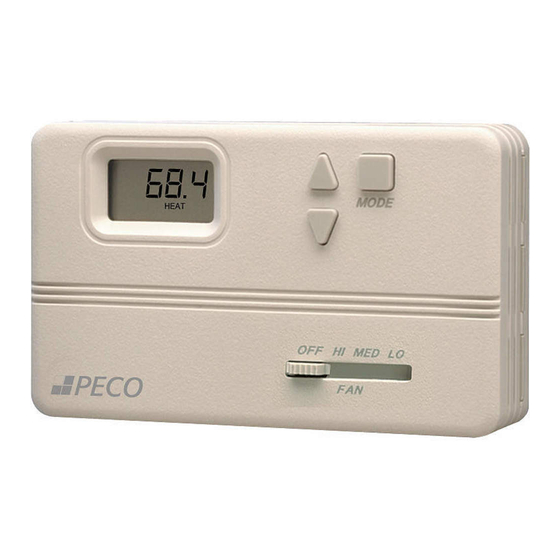Table of Contents
Advertisement
Quick Links
INSTALLATION INSTRUCTIONS
1. Install the T158 with the two furnished mounting screws to a
standard 4-11/16" x 2-1/8" square device box with a 2" x 4"
adapter ring.
2. For wall installations, mount the thermostat on an inside wall
approximately 5 feet above the floor.
provide circulation at average room temperature. Avoid direct
sunlight or sources of hot or cold air in the room or wall.
3. Remove the cover. Mount thermostat base assembly to the
outlet box using the screws provided, tighten the screws evenly
but do not over tighten.
appropriate wiring diagram for your thermostat style.
4. To use a remote sensor on units with local sensing capability,
remove jumper JP-1 to disable local sensing. Failure to remove
JP-1 will cause improper operation of the thermostat.
5. Remove the LCD plastic protective film. Reinstall the cover
assembly. Install the cover locking screw provided in the hole at
the left side of the control enclosure to complete the installation.
6. Checkout: After wiring and installation are complete, energize
the system and check the operation. Adjust the thermostat as
necessary to complete at least one cycle.
thermostat and all other equipment are functioning correctly.
Use copper wire only, insulate or wire nut all un-used
leads.
Care should be used to avoid electrostatic discharge to
the microprocessor.
This unit has configuration jumpers. You may need to re-
configure this thermostat for your application.
See page 2.
L1 (HOT)
1
LO
2
MED
3
HIGH
4
OR SINGLE SPEED FAN
24 VAC 1
5
24 VAC 2
6
SETBACK INPUT
7
MAIN 1 OPEN
10
SEC 1 OPEN
11
MAIN 2 CLOSE
12
SEC 2 CLOSE
13
14
15
16
17
WIRING DIAGRAM FOR 3-WIRE VALVE
CONFIGURATION
© COPYRIGHT 2005 PECO, INC. ALL RIGHTS RESERVED
The location should
Connect wires as shown in the
Be sure the
CAUTION
L2 OR NEUTRAL
FAN
24 VAC
XFMR
MAIN
SECONDARY
OUTSIDE AIR
DAMPER OUTPUT
REMOTE PROBE
PIPE SENSOR
MICROPROCESSOR THERMOSTAT
WARNING
READ THESE INSTRUCTIONS CAREFULLY BEFORE
ATTEMPTING TO INSTALL, OPERATE OR SERVICE
THIS THERMOSTAT.
Failure to observe safety information and comply with
instructions could result in PERSONAL INJURY, DEATH
AND/OR PROPERTY DAMAGE.
To avoid electrical shock or damage to equipment,
disconnect power before installing or servicing.
To avoid potential fire and/ or explosion do not use in
potentially flammable or explosive atmospheres.
Retain these instructions for future reference.
product, when installed, will be part of an engineered
system whose specifications and performance
characteristics are not designed or controlled by PECO.
You must review your application and national and local
codes to assure that your installation will be functional and
safe.
FAN AND SYSTEM SWITCHES
VOLTAGE
INDUCTIVE
RATING
LRA
FLA
24 VAC
NA
NA
120 VAC
5.8
34.8
240 VAC
2.9
17.4
277 VAC
2.4
14.4
L1 (HOT)
1
LO
2
MED
3
HIGH
4
OR SINGLE SPEED FAN
24 VAC 1
5
24 VAC 2
6
SETBACK INPUT
7
MAIN 1
10
SEC 1
11
FAN
12
HEAT 2
13
14
15
16
17
WIRING DIAGRAM FOR ON/OFF OUTPUT
CONFIGURATION
TB158
On/Off and 3-Wire Controller
THERMOSTATIC
SWITCHING
RESISTIVE
PILOT
(Pilot Duty)
AMPS
DUTY
NA
24 VA
6.0
125 VA
5.0
125 VA
4.2
125 VA
L2 OR NEUTRAL
FAN
MAIN 1
OUTPUT
SECONDARY
1 OUTPUT
DEMAND
OUTPUT
2ND STAGE
HEAT
OUTSIDE AIR
DAMPER OUTPUT
REMOTE PROBE
PIPE SENSOR
P/N 68838 3220-1472 Rev 0
This
10 VA
N.A.
N.A.
N.A.
24 VAC
XFMR
Page 1
Advertisement
Table of Contents

Subscribe to Our Youtube Channel
Summary of Contents for Peco TB158
- Page 1 Adjust the thermostat as necessary to complete at least one cycle. Be sure the characteristics are not designed or controlled by PECO. thermostat and all other equipment are functioning correctly. You must review your application and national and local codes to assure that your installation will be functional and safe.
-
Page 2: Thermostat Operation
Secondary 2 outputs (stroke time can be changed). OUTSIDE AIR DAMPER OPERATION 2. At the end of three minutes, the TB158 will stop closing the This output is ON any time the control is turned ON. valves by removing power from the Main 2 and Secondary 2 outputs.
















Need help?
Do you have a question about the TB158 and is the answer not in the manual?
Questions and answers